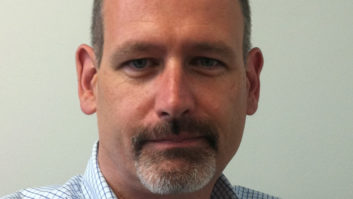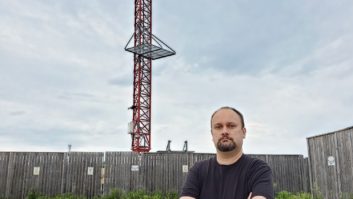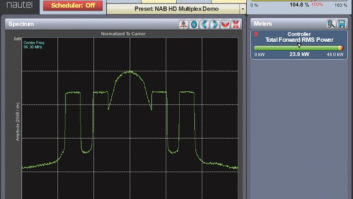More information is dribbling out of the NAB Radio Technology Committee about its plans to test all-digital AM HD Radio technology on an existing radio station.
A test station has been chosen. Look for testing to begin “probably right after the presidential elections,” said CBS Radio Senior Vice President of Engineering Glynn Walden during the fall Radio Show, speaking as a member of the group.
Walden and other committee members declined to identify the facility. Other committee members told Radio World it is a CBS station in an area that could be characterized as a medium-sized market.
The committee has been meeting since last November to discuss technical options for the revitalization of AM. Testing would quantify both indoor and outdoor coverage. In general, the goal is to verify whether the station coverage and robustness are improved with an all-digital signal — both day and night — and to quantify any change. There’s little technical data in the public arena for all-digital AM operation, said one source.

iStockphoto/Pavel Ignatov Testing an all-digital option is one of several possible solutions to help AM stations being discussed by the committee. A third member emphasized that the decision to test does not necessarily mean the all-digital option is the one the committee prefers. “It’s just one we can work on first.”
The group is trying to assess several ideas proposed in an engineering report commissioned by the NAB board and prepared by an outside consulting engineering firm. One source described that report as a “laundry list” of every conceivable idea that could help the band.
Committee members say other ideas to pursue with the FCC could include options such as further relaxation of proof of performance rules or allowing more AMs to operate on FM translators.
The commission itself has expressed interest in helping AMs thrive; and at the fall convention, Commissioner Ajit Pai called for the formation of an FCC committee to revitalize AM radio.
More to come?
Now that one station is on board for all-digital testing, the committee hopes member radio groups will offer other facilities, according to the six members interviewed for this article.
The hope is to test all-digital AM on a variety of facilities — ideally three or four — with various equipment configurations and antenna systems. The group has received offers of possible AMs to use for testing from owners who have not gone digital and/or are on the expanded portion of the band. Ideally, they’d like to use stations that have digital gear already installed and operational.
Beasley Broadcasting is particularly interested in all-digital testing. Vice President/Chief Technology Officer Mike Cooney said, “Beasley is committed to supporting an all-digital AM test but we have not made a decision on which (or if) one of our AM HD signals fits the requirement.”
Still to be determined is who would pay for such testing and who would perform the trials, though it’s likely an outside engineering contractor would perform the tests, according to several committee sources.
IBiquity Digital would provide equipment or other support needed for testing, according to President/CEO Bob Struble.
The company has conducted testing of its all-digital system in the past on its original experimental station in Cincinnati and a CBS station in Los Angeles. Anecdotal tests were done as recently as last year on an iBiquity experimental station in Frederick, Md. The tests showed “significant improvement” in all-digital signal coverage compared to the current hybrid AM HD system, according to two non-committee sources familiar with the work.
While current HD Radio receivers could receive an all-digital signal, testers will be interested to explore the impact on analog-only receivers; right now, that’s presumed to be hiss or static.
Analog transmission would be turned off as part of the testing, presumed to occur in both day and night. That’s one big reason why all-digital testing is controversial and committee members cautious in discussing it. Broadcasters do not want to spook advertisers, who typically have a year-long contract with a station, with “a test that lasts a few weeks,” said one source close to the issue.
Fuzzy future
But the topic is contentious for reasons beyond the mechanics of testing.
HD Radio’s “hybrid” system was designed with the idea that it would give radio the option of moving someday to all-digital broadcasting; but that was always for some distant future.
Discussion of actually doing that across the band raises the specter of millions of AM analog receivers being made obsolete and thousands of radio stations having to choose whether to upgrade transmission facilities. Avoiding obsolescence is one reason the industry chose to adopt IBOC and a transitional “hybrid” path, rather than a system using another band, such as DAB, which would have obsoleted receivers right away.
Serious discussion over all-digital AM may just be starting. The conversation about an all-digital AM option presumes that a future transition would be voluntary, not mandated. But even under a voluntary scenario, future debate on this topic is likely to include the consequences to existing AM listening and to dial neighbors.
In August, Radio World broke the story that engineers at major radio groups within NAB were considering all-digital testing. Commentary generated by that story on Radio World’s website and elsewhere “tells us the kind of” debate the industry is going to have to face, said one expert.
For example, several commenters said that any testing for an all-digital AM future should involve both HD Radio and Digital Radio Mondiale. DRM supporters say consumer-grade receivers are “coming.” Others say the lack of any established consumer receiver base makes comparison testing difficult.
Some commenters tout the value of moving AMs to FM translators and then moving some or all of those to TV Channels 5 and 6, instead of (or in addition to) exploring all-digital AM; but that raises the question of what happens to TV stations who’ve told the FCC they intend to remain on those channels.
Another commenter argued that the HD Radio system is the most efficient path to all-digital at a time when spectrum is becoming more precious.
“Our government won’t give us any spectrum,” one source said. “They may not take away what we’ve got, but they’re certainly not giving us any more.”
Another observer commented that some critics may not understand the nuances AM owners face in trying to get a regulatory scheme through the FCC.
According to its backers, criticism of the iBiquity AM system serves little purpose at this point because it’s the technology the industry has available to it. Meanwhile, they say, traditional “distance listening,” long enjoyed by many analog AM stations, has become less relevant as more consumers move closer to cities. Further, people under 25 have no significant awareness of the AM band, so some action to improve the situation is needed.
“People simply don’t look there for anything,” said one observer of the AM band. “So if there’s a new technology that gets them to what they want to hear with the device they’ve got, be that AM/FM, Pandora or whoever, it’s up to the marketing to tell people where to find it.” It’s an era when consumers generally no longer hit “seek” on a radio anymore to find a frequency or station.
Yet given the history of debate over HD Radio, particularly over its AM implementation, the discussion over whether and how to pursue an all-digital AM option is likely to be heated.
Confidential report
Meanwhile, the NAB committee’s report about options to improve AM has not been made public — and may never be. The association has said it has no current plans to release the document publicly.
A committee source said the report is extremely technical and would need to be explained and/or possibly watered down for consumption by non-engineers.
Asked why discussions about options for AM improvement are taking place behind closed doors, engineers told Radio World they are following the wishes of the NAB board, which consists of executives from member radio groups.
Closed meetings are typical in such situations, according to the leader of one NAB member company. The executive said that if such meetings were open to reporters, no one would feel free to participate and no work would be accomplished.











